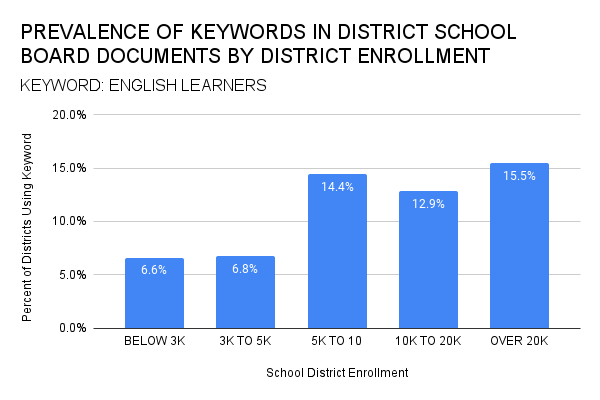1. A recurring observation we have heard from K-12 stakeholders is the challenge in identifying special revenue sources that are state-specific. This week we are introducing a State-Level Funding Tracker to better organize the information. This supplements our other datasets, which include ESSER III, strategic plans, school board meeting minutes, CapEx budgets, and more.
In Burbio's history we have done work normalizing highly fragmented, unstructured, time-sensitive K-12 datasets, such as our work on school openings during Covid and tabulating over $90 billion of ESSER III spending plans. An important step is to create a framework for the information. We have identified these elements for state-level funding:
- Grant name, Purpose, and Category
- Application Deadline
- District Eligibility
- Public or Private
- Is the Funding Competitive - Yes or No
- Whether districts are already been awarded or allocated the funding, and if so, which ones
- Total Amount of Funding availability
Some other notes:
- Clients have helped us identify over two dozen categories including school security, technology, early childhood, infrastructure, CTE, professional development, SEL, mental health, arts, STEM, core curriculum, and many more, and we continue to iterate.
- Funding sources often apply to multiple areas of services and need to be classified as such.
- In addition to tracking funding that originates at the state level we will be tracking Federal funding where states are given latitude in how to distribute the resources.
- While most state-level funding comes through education departments, there are examples of funding available from other departments and agencies that school districts also can tap into, and that is incorporated.
From stakeholders in the industry we have heard three primary use cases for this information:
- Evaluate market and industry trends.
- Identify potential district partners based on what is available in a given state.
- Coach districts on funding opportunities. A widespread refrain is that districts are frequently unaware of what is available to them in their own state.
The Burbio School Tracker will provide aggregate analysis of this funding similar to the way we have discussed our other datasets. This week we'd like to start by giving some examples of the variety of funding available.
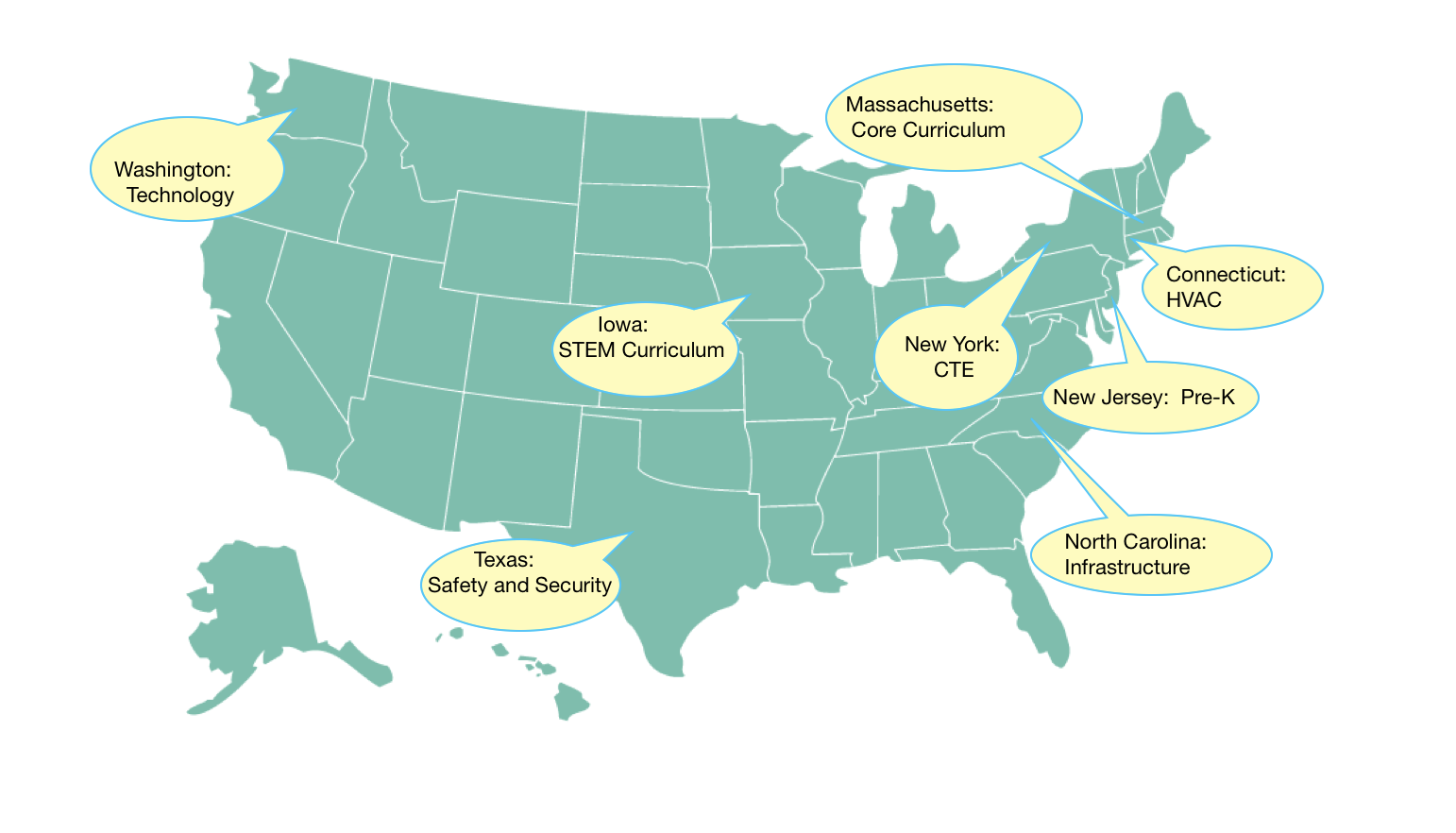
It is difficult to overstate the variety of funding sources across every state, so there is no such thing as a representative list. We did want to present some examples from across the country in just a handful of categories:
- Pre-K: In November, New Jersey awarded an additional $51.9 million in federal grant funding from the state to 23 school districts to support 30 projects that will enable the creation, expansion, and renovation of preschool facilities statewide. Preliminary award amounts range from approximately $113,000 to over $13 million.
- Infrastructure: In North Carolina the application-based Needs-Based Public School Capital Fund (NBSCF), funded through the state lottery, has $254MM to grant for construction of new school buildings and additions, repairs, and renovations of existing school facilities for lower income school districts.
- Curriculum: STEM: Iowa is offering up to $40,000 in matching grants to school districts that launch new or expanded K-12 STEM models specifically focused on creating work based learning opportunities that allow students to develop future focused, high demand skills through authentic real world experiences.
- CTE: The New York State Pathways in Technology Early College High School (NYS P-TECH) Program anticipates that up to $31.5 million will be available over the seven-year grant term (2023-2030). The project funds partnerships to prepare New York students for high-skilled jobs in the fields of technology, and manufacturing. The current application period has closed but the NYS FY 2024 Executive Budget includes an additional $20 million in grant funding to support the establishment of new ECHS and P-TECH programs.
- Technology: Washington state awarded its second cycle of Digital Equity & Inclusion Grants focused on 1:1 device programs; inclusionary and adaptive technology; interactive displays on accessible mounts; classroom audio enhancement; devices for special education students;, and tools, software, and hardware that supports multi-language learners.
- Curriculum: Core: In Massachusetts, the Genocide Education grants program ”supports LEAs to develop and/or select curriculum materials, implement professional development, and design other enriching learning experiences intended to further secondary students' understanding of the history and patterns of genocide.” Of the total $1,250,000, the largest grant is $60,000. The funds must be spent on curriculum and instructional materials but may not be used for technology or salaries.
- HVAC: Connecticut’s newly established “HVAC Indoor Air Quality Grants Program for Public Schools” offers $150 million in grants to make upgrades to heating, ventilation, and air conditioning (HVAC) systems. This new HVAC grant draws half its funding from the state and the other half from the state’s remaining share of federal American Rescue Plan Act (ARPA) funds. A partial list of schools that have already received funds can be found here.
- Safety and Security: Among multiple ongoing security funding sources in Texas is the SAFE Grant program which provides $800 million to districts and the GEER Assistance to Private Schools (GAPS) Grant Program funded in part by Federal dollars.
2. Burbio tracks ESSER III spending by districts nationally and this week we profile ESSER III spending in Oregon.
- To date, Oregon districts have spent in aggregate 47% of ESSER III dollars and have over $500MM remaining.
- Twenty-seven districts have between $5MM and $50MM remaining and one has over $50MM remaining.
The chart below breaks down the number of districts and the amount they have remaining:
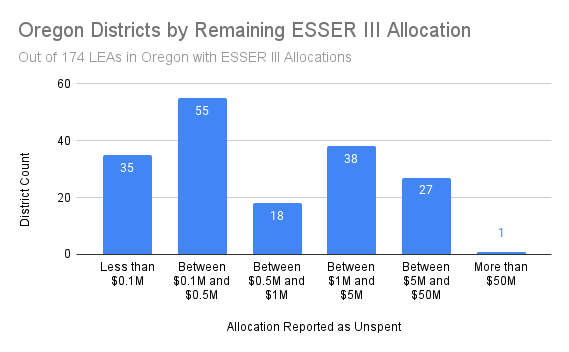
Below is a breakout by decile of percent of allocation that has been spent:
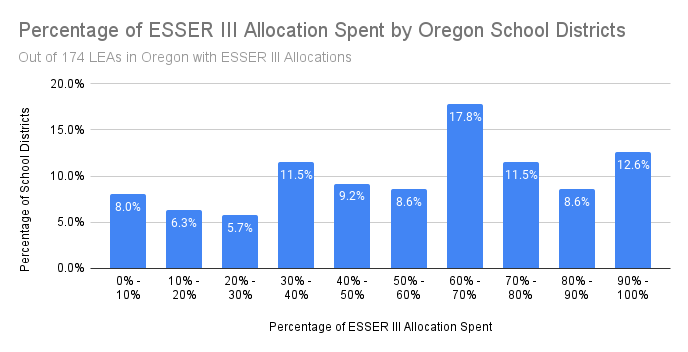
3. Burbio is now tracking school board meeting minutes covering over 50% of the K-12 public school population. School board meetings cover all facets of school district operations, and partners use the information to determine district intent around purchasing and policy decisions. This week we continue our look at terminology used in board meetings based on district size.
The analysis below covers only the most recent board meetings from over 1,700 districts with 25 million students. By measuring only the most recent board meeting we get particular insight into some of the more widely covered topics.
The first term we look at is HVAC, mentioned in over15% of district board meetings for districts over 20,000 students on a monthly basis:
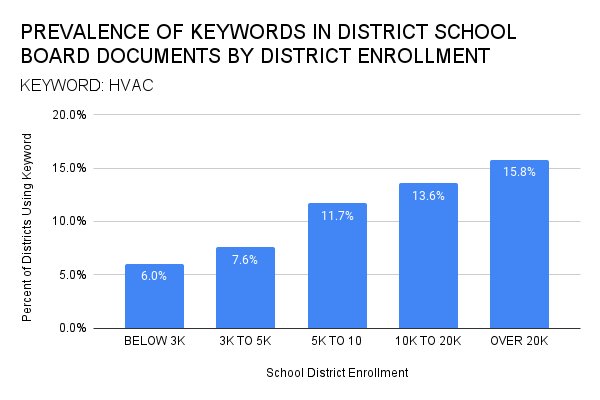
Next up is English Learners. There is a big jump in frequency for districts of over 5,000 students:
